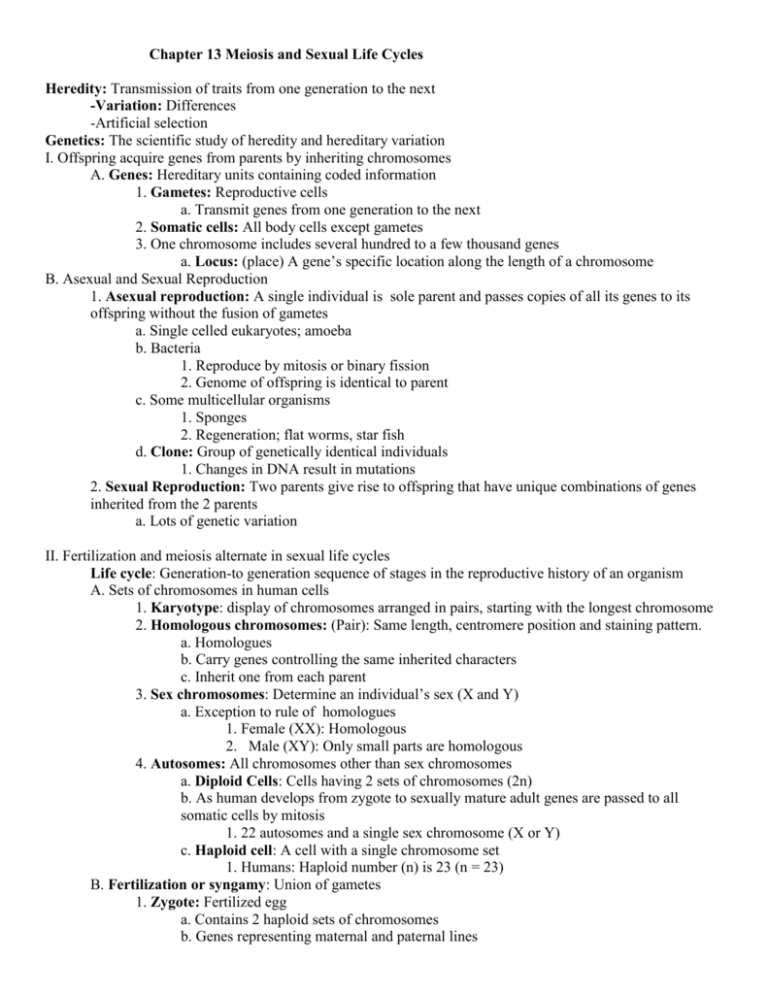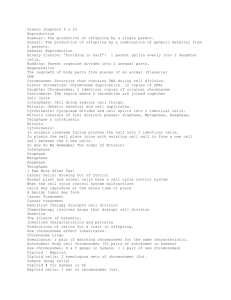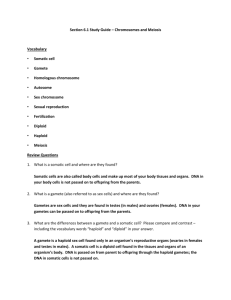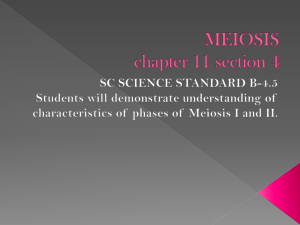Chapter 13 Meiosis and Sexual Life Cycles Heredity: Transmission
advertisement

Chapter 13 Meiosis and Sexual Life Cycles Heredity: Transmission of traits from one generation to the next -Variation: Differences -Artificial selection Genetics: The scientific study of heredity and hereditary variation I. Offspring acquire genes from parents by inheriting chromosomes A. Genes: Hereditary units containing coded information 1. Gametes: Reproductive cells a. Transmit genes from one generation to the next 2. Somatic cells: All body cells except gametes 3. One chromosome includes several hundred to a few thousand genes a. Locus: (place) A gene’s specific location along the length of a chromosome B. Asexual and Sexual Reproduction 1. Asexual reproduction: A single individual is sole parent and passes copies of all its genes to its offspring without the fusion of gametes a. Single celled eukaryotes; amoeba b. Bacteria 1. Reproduce by mitosis or binary fission 2. Genome of offspring is identical to parent c. Some multicellular organisms 1. Sponges 2. Regeneration; flat worms, star fish d. Clone: Group of genetically identical individuals 1. Changes in DNA result in mutations 2. Sexual Reproduction: Two parents give rise to offspring that have unique combinations of genes inherited from the 2 parents a. Lots of genetic variation II. Fertilization and meiosis alternate in sexual life cycles Life cycle: Generation-to generation sequence of stages in the reproductive history of an organism A. Sets of chromosomes in human cells 1. Karyotype: display of chromosomes arranged in pairs, starting with the longest chromosome 2. Homologous chromosomes: (Pair): Same length, centromere position and staining pattern. a. Homologues b. Carry genes controlling the same inherited characters c. Inherit one from each parent 3. Sex chromosomes: Determine an individual’s sex (X and Y) a. Exception to rule of homologues 1. Female (XX): Homologous 2. Male (XY): Only small parts are homologous 4. Autosomes: All chromosomes other than sex chromosomes a. Diploid Cells: Cells having 2 sets of chromosomes (2n) b. As human develops from zygote to sexually mature adult genes are passed to all somatic cells by mitosis 1. 22 autosomes and a single sex chromosome (X or Y) c. Haploid cell: A cell with a single chromosome set 1. Humans: Haploid number (n) is 23 (n = 23) B. Fertilization or syngamy: Union of gametes 1. Zygote: Fertilized egg a. Contains 2 haploid sets of chromosomes b. Genes representing maternal and paternal lines c. Gametes develop in gonads (ovaries and testes) 1. If by mitosis chromosome number would double with every cell division 2. Meiosis: Cell division that halves chromosome number in gametes (germ cells) III. The Variety of Sexual Life Cycles; 3 main groups 1. Animals a. Meiosis occurs during production of gametes b. No further division prior to fertilization c. Diploid zygote divides by mitosis 1. Multicellular organisms is diploid 2. Fungi and some protists including algae a. Gametes fuse to form diploid zygote b. Meiosis occurs before offspring develop 1. Does not produce gametes 2. Haploid cells that divide by mitosis 1. Result: Haploid multicellular adult a. Produces gametes by mitosis b. Zygote: Only diploid stage: 3.Plants and some species of algae a. Alternation of generations: Includes both diploid and haploid multicellular stages 1. Sporophyte: Multicellular diploid stage 2. Spores: Haploid cells a. Produced by meiosis the sporophyte b. Gives rise to multicellular individual without fusing with another cell c. Divides mitotically d. Produces Gametophyte: Multicellular haploid stage 1. Makes gametes by mitosis 2. Fertilization results in diploid zygote a. Develops into sporophyte C. Meiosis reduces chromosome number -Preceded by chromosome replication -Meiosis I and Meiosis II: 2 consecutive divisions a. 4 daughter cells with half the chromosomes as parent cells c. Homologues have different versions of genes at some of their corresponding loci 1. Interphase a. Chromosomes replicate b. Centrosomes replicate Meiosis I 2. Prophase I a. Chromosomes condense b. Homologues pair up c. Synapsis: Duplicated chromosomes pair with homologues 1. Synaptonemal complex: Protein structure a. Attaches homologous chromosomes tightly together all along lengths b. Disappears in late prophase c. Tetrad: Cluster of 4 chromatids 2. Chiasmata: Various places where homologous chromosomes are crisscrossed a. Holds homologous pairs together until anaphase I 3. Crossing over of nonsister chromatids d. Centrosomes move away from each other e. Spindle microtubules form between them f. Nuclear envelope and nucleoli disperse g. Spindle microtubules capture kinetochores h. Chromosomes begin moving to metaphase plate i. Lasts days or longer (90% of time for meiosis) 3. Metaphase I: a. Chromosomes arranged on metaphase plate b. Kinetochore microtubules from poles attach to one chromosome of each pair 4. Anaphase I: a. Spindle apparatus guides movement of chromosomes toward poles b. Sister chromatids remain attached at their centromeres 1. Moves as a single unit toward pole a. Separates homologous pairs 1. Not sister chromatids 5. Telophase I and Cytokinesis: a. Each pole has a haploid chromosome set 1. Chromosome still has 2 sister chromatids b. Cytokinesis happens simultaneously 1. 2 daughter cells 6. Prophase II: a. Spindle apparatus forms b. Chromosomes move toward metaphase II plate 7. Metaphase II: a. Chromosomes positioned on metaphase plate b. Kinetochores of sister chromatids pointing toward poles 8. Anaphase II: a. Centromeres of sister chromatids separate b. Move toward opposite poles Telophase II and Cytokinesis: a. Nuclei form at opposite poles b. Cytokinesis 1. 4 haploid daughter cells D. Mitosis and Meiosis Compared III. Origins of Genetic Variation A. Sexual life cycles produce genetic variation (3 types) 1. Independent Assortment a. Random alignment b. 2 possibilities for each pair 1. 50% chance that daughter cell will get maternal chromosome of certain homologous pair 2. 50% chance of receiving paternal chromosome c. Number of combinations possible for gametes 1. Ex: 2 homologous pairs (n = 2) 2n = 22 = 4 possibilities 2. Ex: n = 3 2n = 23 = 8 combinations of chromosomes d. Humans: 2n = 223 = 8 388 608 2. Crossing over: Process which combines genes inherited from both parents a. Recombinant chromosomes: Result of crossing over b. Begins in early prophase I 1. Before synaptonemal complex forms c. Aligns homologues gene by gene 1. Homologous portions of 2 nonsister chromatids trade places d. Humans: 2 or 3 crossover events per chromosome pair e. Metaphase II: Recombinant chromatids can be oriented in two alternative nonequivalent ways 1. Further increases 3. Random Fertilization (human) a. Ovum represents 1 in 8 388 608 possibilities b. Sperm represents 1 in 8 388 608 possibilities c. Without considering crossover 1. 8 388 6082 = Over 7.03 x 1013 diploid combinations 2. Zygote with one of over 70 trillion different possibilities








